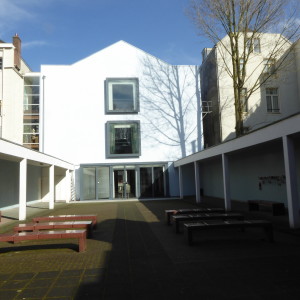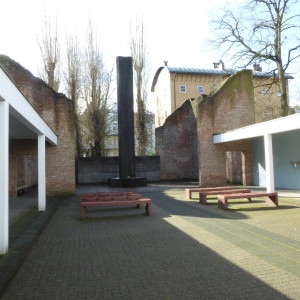Manet van Montfrans: ‘Des sites et des lieux. ‘De Hollandsche Schouwburg: Bâtiment des larmes’. In Ph. Mesnard, Luba Jurgenson (éds), Mémoires en Jeu/Memories at Stake, no 1, septembre 2016, 128-133; Encyclopédie critique du témoignage et de la mémoire, Lieux de mémoire.
En ligne: http://memories-testimony.com/lieu-memoriel/de-hollandsche-schouwburg-lieu-de-memoire-amsterdam/

Abstract
Until 1940, The Hollandsche Schouwburg, located just outside the Jewish quarter of Amsterdam, was a popular theatre, putting on many well-known Dutch plays. In 1941 the Nazi occupiers changed the theatre’s name into Joodsche Schouwburg (Jewish Theatre). After that, only Jewish actors and artistes were allowed to perform there – for a strictly Jewish audience. Between July 1942 and November 1943 more than 46.000 Jewish men, women and children were detained in the theatre and transported from there to the Dutch transit camps in Westerbork or Vught. These were the last stop before they were herded into trains bound for one of the extermination camps.
The Creche, a day nursery located opposite The Hollandsche Schouwburg, was annexed for Jewish children. They were separated from their parents while they awaited deportation. Walter Süskind, a Jew who had fled Germany in 1938 and was a member of the Dutch Jewish Council (Judenrat), had been designated by the Nazis as the manager of The Schouwburg. He decided to start rescuing hundreds of children. Helped by several Dutch Resistance groups around 600 children were smuggled out of the Creche through the adjacent Hervormde Kweekschool (Teacher Training College). A crucial role was played by the assistants of the Creche and the Director of the School.
After the liberation, attempts to put on public performances in the Hollandsche Schouwburg led to a storm of protest. In 1949 the theatre was sold to the Hollandsche Schouwburg Comittee, aimed at preventing the Schouwburg from ever being used again as a theatre. The Comittee donated the building to the city council of Amsterdam, but only after long years of discussions and controversy within the Jewish Community and with the city council , the decision was taken to transform the neglected buildings of the Schouwburg into a Memorial Site.
In 1962, the city council of Amsterdam inaugurated a monument here in remembrance of the Jewish victims of the Nazi terror. In 1993, a memorial chapel was installed, listing the 6 700 family names of the 104 000 Jews from the Netherlands who were murdered in the war. Today, the Hollandsche Schouwburg serves as a monument and war memorial.
Actually, the project of reuniting the two buildings,The Hollandsche Schouwburg and the former Hervormde Kweekschool directly across the street, in a National Shoa Museum, is being carried out, in order to tell the comprehensive story of the persecution, deportation and murder of more than three-quarters of the Netherlands’ Jews (104.000). On May 15th 2016 a first exhibition space in the former Kweekschool has been inaugurated by the Mayor of Amsterdam.
Since 2005, the Dutch Auschwitz Committee has endeavoured to establish a Holocaust Memorial of Names that will bear the names of all the Dutch Holocaust Victims, including Roma and Sinti. A design for the Memorial has been made by the American architect of Polish-Jewish descent Daniel Libeskind. A longstanding controversy about the location of this voluminous Monument has been solved in April 2016: all involved parties seem
to rest their case.
